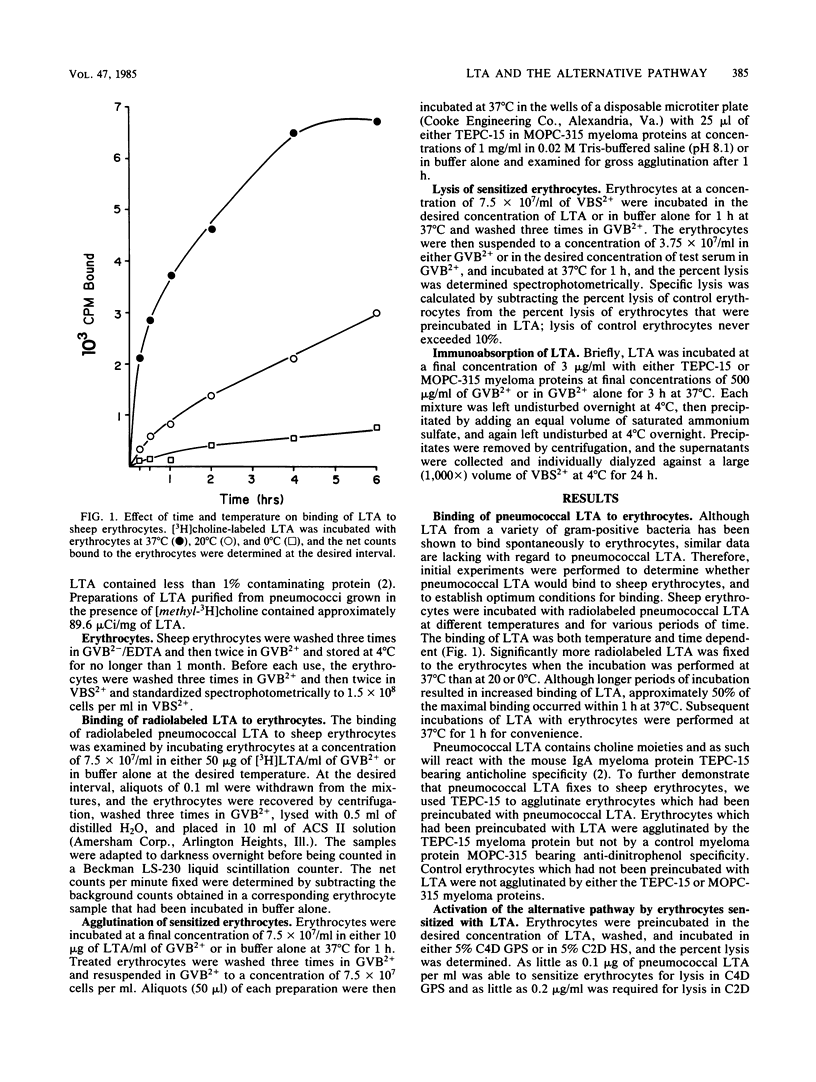Abstract
Cell wall teichoic acids of some gram-positive bacteria are potent activators of the alternative pathway of complement. It is unclear, however, whether the other form of teichoic acid, cell membrane lipoteichoic acid (LTA), can also activate the alternative pathway. In the present study, radiolabelled pneumococcal LTA was found to bind spontaneously to sheep erythrocytes in a temperature- and time-dependent fashion. In addition, the presence of pneumococcal LTA on the erythrocyte surface was verified by the fact that they could be agglutinated by a myeloma protein (TEPC-15) specific for choline, a constituent of pneumococcal LTA. Pneumococcal LTA when fixed to the surface of erythrocytes was able to activate the alternative pathway of complement in both guinea pig serum deficient in the fourth component of complement and human serum deficient in the second component of complement, resulting in lysis of the sensitized erythrocytes. The sensitizing principle of the LTA preparation was removed before erythrocyte sensitization by immunoabsorption, using the choline-specific TEPC-15 myeloma protein. These data demonstrate that purified pneumococcal LTA will bind to sheep erythrocytes and endow them with the ability to activate the alternative pathway.
Full text
PDF



Selected References
These references are in PubMed. This may not be the complete list of references from this article.
- Beachey E. H. Bacterial adherence: adhesin-receptor interactions mediating the attachment of bacteria to mucosal surface. J Infect Dis. 1981 Mar;143(3):325–345. doi: 10.1093/infdis/143.3.325. [DOI] [PubMed] [Google Scholar]
- Briles E. B., Tomasz A. Pneumococcal Forssman antigen. A choline-containing lipoteichoic acid. J Biol Chem. 1973 Sep 25;248(18):6394–6397. [PubMed] [Google Scholar]
- Ellman L., Green I., Frank M. Genetically controlled total deficiency of the fourth component of complement in the guinea pig. Science. 1970 Oct 2;170(3953):74–75. doi: 10.1126/science.170.3953.74. [DOI] [PubMed] [Google Scholar]
- Fearon D. T. Activation of the alternative complement pathway. CRC Crit Rev Immunol. 1979 Nov;1(1):1–32. [PubMed] [Google Scholar]
- Fiedel B. A., Jackson R. W. Activation of the alternative complement pathway by a streptococcal lipoteichoic acid. Infect Immun. 1978 Oct;22(1):286–287. doi: 10.1128/iai.22.1.286-287.1978. [DOI] [PMC free article] [PubMed] [Google Scholar]
- Hyatt A. C., Altenburger K. M., Johnston R. B., Jr, Winkelstein J. A. Increased susceptibility to severe pyogenic infections in patients with an inherited deficiency of the second component of complement. J Pediatr. 1981 Mar;98(3):417–419. doi: 10.1016/s0022-3476(81)80708-1. [DOI] [PubMed] [Google Scholar]
- Joseph R., Shockman G. D. Synthesis and excretion of glycerol teichoic acid during growth of two streptococcal species. Infect Immun. 1975 Aug;12(2):333–338. doi: 10.1128/iai.12.2.333-338.1975. [DOI] [PMC free article] [PubMed] [Google Scholar]
- Knox K. W., Wicken A. J. Immunological properties of teichoic acids. Bacteriol Rev. 1973 Jun;37(2):215–257. doi: 10.1128/br.37.2.215-257.1973. [DOI] [PMC free article] [PubMed] [Google Scholar]
- Saulsbury F. T., Winkelstein J. A. Activation of the alternative complement pathway by L-phase variants of gram-positive bacteria. Infect Immun. 1979 Mar;23(3):711–716. doi: 10.1128/iai.23.3.711-716.1979. [DOI] [PMC free article] [PubMed] [Google Scholar]
- Simpson W. A., Ofek I., Beachey E. H. Binding of streptococcal lipoteichoic acid to the fatty acid binding sites on serum albumin. J Biol Chem. 1980 Jul 10;255(13):6092–6097. [PubMed] [Google Scholar]
- Tauber J. W., Polley M. J., Zabriskie J. B. Nonspecific complement activation by streptococcal structures. II. Properdin-independent initiation of the alternate pathway. J Exp Med. 1976 Jun 1;143(6):1352–1366. doi: 10.1084/jem.143.6.1352. [DOI] [PMC free article] [PubMed] [Google Scholar]
- Tomasz A. Cellular metabolism in genetic transformation of pneumococci: requirement for protein synthesis during induction of competence. J Bacteriol. 1970 Mar;101(3):860–871. doi: 10.1128/jb.101.3.860-871.1970. [DOI] [PMC free article] [PubMed] [Google Scholar]
- Webster G. F., Nilsson U. R., McArthur W. P. Activation of the alternative pathway of complement in human serum by Propionibacterium acnes (Corynebacterium parvum) cell fractions. Inflammation. 1981 Jun;5(2):165–176. doi: 10.1007/BF00914205. [DOI] [PubMed] [Google Scholar]
- Wicken A. J., Knox K. W. Lipoteichoic acids: a new class of bacterial antigen. Science. 1975 Mar 28;187(4182):1161–1167. doi: 10.1126/science.46620. [DOI] [PubMed] [Google Scholar]
- Wilkinson B. J., Kim Y., Peterson P. K., Quie P. G., Michael A. F. Activation of complement by cell surface components of Staphylococcus aureus. Infect Immun. 1978 May;20(2):388–392. doi: 10.1128/iai.20.2.388-392.1978. [DOI] [PMC free article] [PubMed] [Google Scholar]
- Winkelstein J. A., Tomasz A. Activation of the alternative complement pathway by pneumococcal cell wall teichoic acid. J Immunol. 1978 Jan;120(1):174–178. [PubMed] [Google Scholar]
- Winkelstein J. A., Tomasz A. Activation of the alternative pathway by pneumococcal cell walls. J Immunol. 1977 Feb;118(2):451–454. [PubMed] [Google Scholar]


